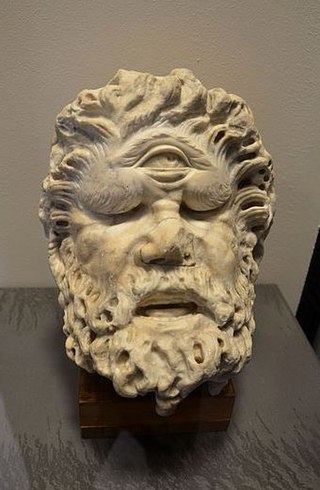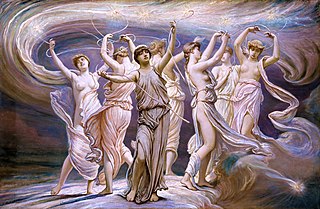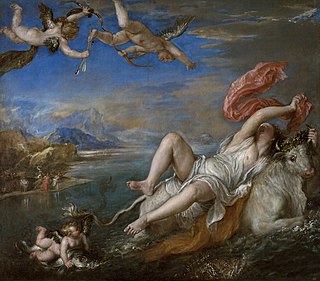
Actaeon, in Greek mythology, was the son of the priestly herdsman Aristaeus and Autonoe in Boeotia, and a famous Theban hero. Through his mother he was a member of the ruling House of Cadmus. Like Achilles, in a later generation, he was trained by the centaur Chiron.

In Greek mythology, Alcmene or Alcmena was the wife of Amphitryon, by whom she bore two children, Iphicles and Laonome. She is best known as the mother of Heracles, whose father was the god Zeus. Alcmene was also referred to as Electryone, a patronymic name as a daughter of Electryon.

In ancient Greek religion and mythology, Artemis is the goddess of the hunt, the wilderness, wild animals, nature, vegetation, childbirth, care of children, and chastity. In later times, she was identified with Selene, the personification of the Moon. She was often said to roam the forests and mountains, attended by her entourage of nymphs. The goddess Diana is her Roman equivalent.

In Greek mythology, Callisto was a nymph, or the daughter of King Lycaon; the myth varies in such details. She was believed to be one of the followers of Artemis who attracted Zeus. Many versions of Callisto's story survive. According to some writers, Zeus transformed himself into the figure of Artemis to pursue Callisto, and she slept with him believing Zeus to be Artemis. She became pregnant and when this was eventually discovered, she was expelled from Artemis's group, after which a furious Hera, the wife of Zeus, transformed her into a bear, although in some versions, Artemis is the one to give her an ursine form. Later, just as she was about to be killed by her son when he was hunting, she was set among the stars as Ursa Major by Zeus. She was the bear-mother of the Arcadians, through her son Arcas by Zeus.

In ancient Greek mythology and religion, Leto is a goddess and the mother of Apollo and Artemis. She is the daughter of the Titans Coeus and Phoebe, and the sister of Asteria.

Zeus is the sky and thunder god in ancient Greek religion and mythology, who rules as king of the gods on Mount Olympus. His name is cognate with the first syllable of his Roman equivalent Jupiter.

Io was, in Greek mythology, one of the mortal lovers of Zeus. An Argive princess, she was an ancestor of many kings and heroes, such as Perseus, Cadmus, Heracles, Minos, Lynceus, Cepheus, and Danaus. The astronomer Simon Marius named a moon of Jupiter after Io in 1614.

In Greek mythology and later Roman mythology, the Cyclopes are giant one-eyed creatures. Three groups of Cyclopes can be distinguished. In Hesiod's Theogony, the Cyclopes are the three brothers Brontes, Steropes, and Arges, who made for Zeus his weapon the thunderbolt. In Homer's Odyssey, they are an uncivilized group of shepherds, the brethren of Polyphemus encountered by Odysseus. Cyclopes were also famous as the builders of the Cyclopean walls of Mycenae and Tiryns.
In Greek mythology, Arcas was a hunter who became king of Arcadia. He was remembered for having taught people the arts of weaving and baking bread and for spreading agriculture to Arcadia.

In Greek mythology, the Oceanids or Oceanides are the nymphs who were the three thousand daughters of the Titans Oceanus and Tethys.

In Greek mythology, Tethys was a Titan daughter of Uranus and Gaia, a sister and wife of the Titan Oceanus, and the mother of the river gods and the Oceanids. Although Tethys had no active role in Greek mythology and no established cults, she was depicted in mosaics decorating baths, pools, and triclinia in the Greek East, particularly in Antioch and its suburbs, either alone or with Oceanus.

In Greek mythology, Endymion was variously a handsome Aeolian shepherd, hunter, or king who was said to rule and live at Olympia in Elis. He was also venerated and said to reside on Mount Latmus in Caria, on the west coast of Asia Minor.

Maia, in ancient Greek religion and mythology, is one of the Pleiades and the mother of Hermes, one of the major Greek gods, by Zeus, the king of Olympus.

The Pleiades, were the seven sister-nymphs, companions of Artemis, the goddess of the hunt. Together with their sisters, the Hyades, they were called the Atlantides, Dodonides, or Nysiades, nursemaids and teachers of the infant Dionysus. The Pleiades were thought to have been translated to the night sky as a cluster of stars, the Pleiades, and were associated with rain.

Argus or Argos Panoptes is a many-eyed giant in Greek mythology.

In Greek mythology, Lycaon was a king of Arcadia who, in the most popular version of the myth, killed and cooked his son Nyctimus and served him to Zeus, to see whether the god was sufficiently all-knowing to recognize human flesh. Disgusted, Zeus transformed Lycaon into a wolf and killed his offspring; Nyctimus was restored to life.

Diana Bathing with her Nymphs with Actaeon and Callisto is a 1634 painting by the Dutch painter Rembrandt van Rijn. It is now in the Salm-Salm princely collection in the Wasserburg Anholt in Anholt, Germany.

The Rape of Europa is a painting by the Venetian artist Titian, painted ca. 1560–1562. It is in the permanent collection of the Isabella Stewart Gardner Museum of Boston, Massachusetts. The oil-on-canvas painting measures 178 by 205 centimetres.

In Greek and Roman mythology, several goddesses are distinguished by their perpetual virginity. These goddesses included the Greek deities Hestia, Athena, and Artemis, along with their Roman equivalents, Vesta, Minerva, and Diana. In some instances, the inviolability of these goddesses was simply a detail of their mythology, while in other cases virginity was also associated with their worship and religious rites.





















